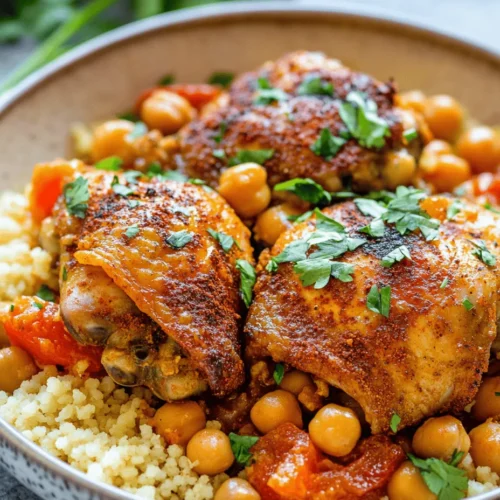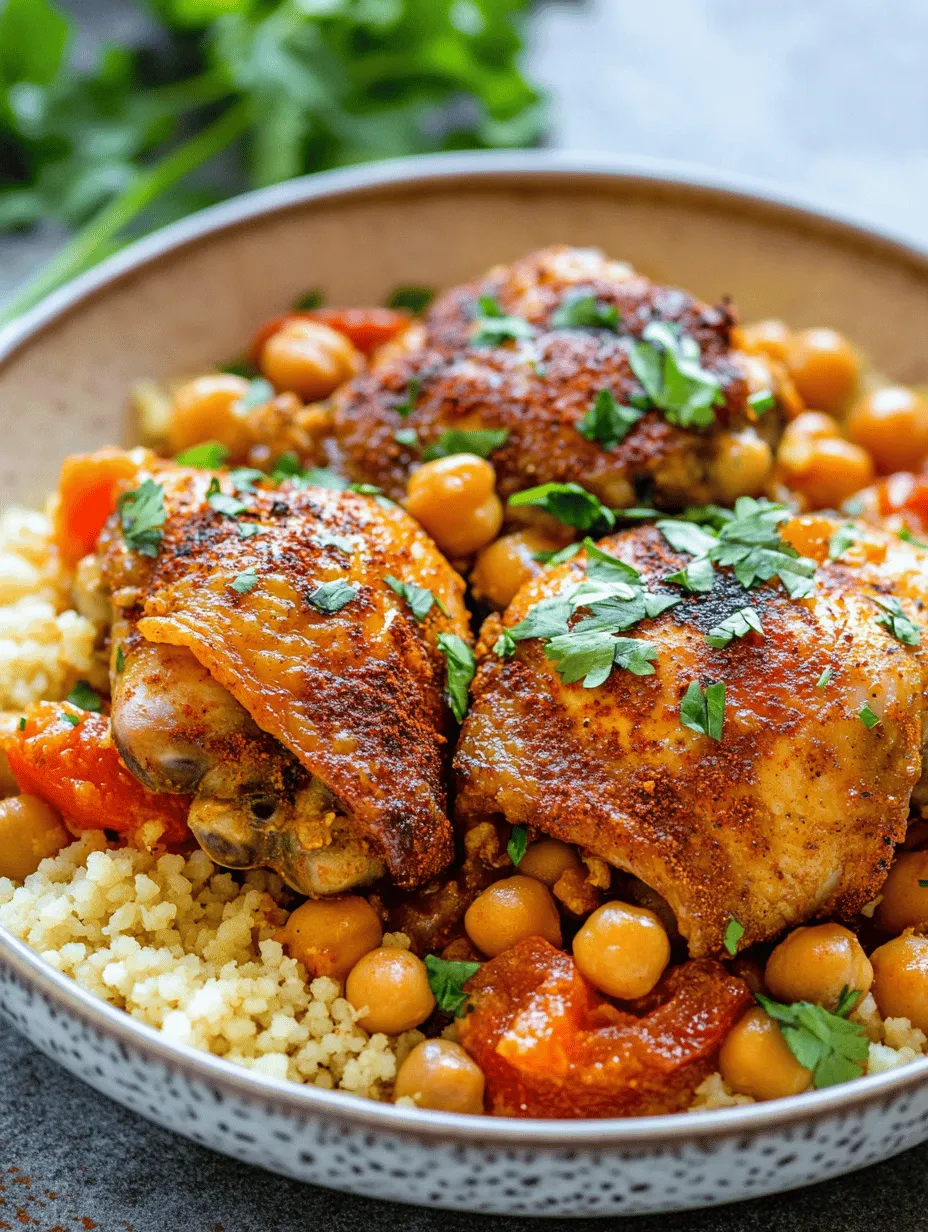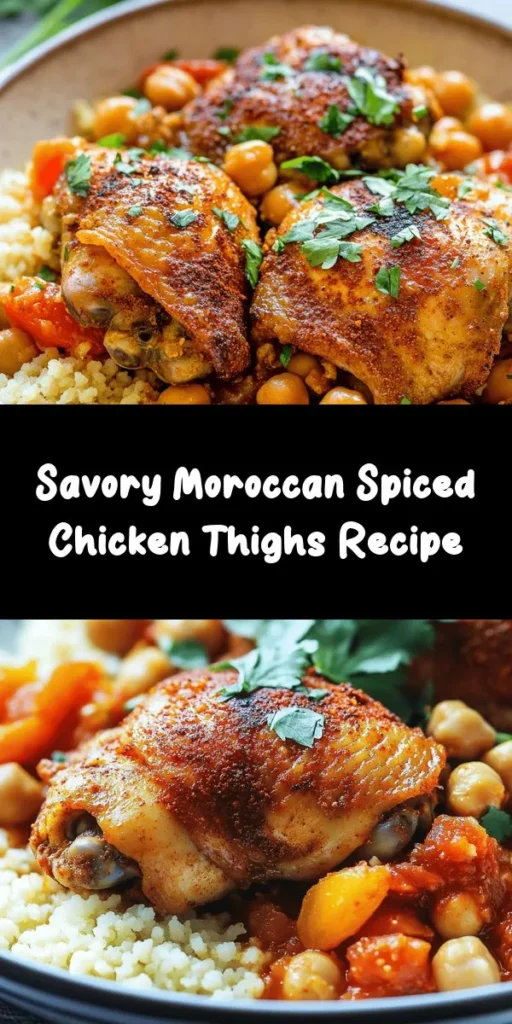Introduction
Moroccan cuisine is renowned for its vibrant flavors, aromatic spices, and diverse culinary traditions. It reflects the rich cultural history of Morocco, where Berber, Arab, and Mediterranean influences converge to create an unforgettable gastronomic experience. Central to this cuisine are dishes that tantalize the palate and evoke the warmth of shared meals. Among these, Moroccan Spiced Chicken stands out as a quintessential representative, showcasing a unique blend of spices that transform humble chicken into a fragrant, comforting dish.
This Moroccan Spiced Chicken recipe invites home cooks to explore international flavors, offering a gateway into the delicious world of Moroccan cooking. With its enticing aroma and rich, layered taste, this dish is perfect for both seasoned chefs and novice cooks looking to impress their families or guests. The combination of spices, tender chicken, and hearty ingredients will transport you to the bustling markets of Marrakech and the sun-soaked landscapes of the Atlas Mountains.
Understanding Moroccan Cuisine
To fully appreciate Moroccan Spiced Chicken, it’s essential to understand the key elements that define Moroccan cooking. At the heart of this cuisine lies a diverse array of spices and herbs that not only add flavor but also offer health benefits. Commonly used spices include cumin, coriander, cinnamon, and saffron, each playing a crucial role in creating the depth of flavor that characterizes Moroccan dishes.
One of the most iconic spice blends in Moroccan cuisine is ras el hanout, which translates to “head of the shop.” This blend is a staple in Moroccan kitchens, often consisting of a mix of over a dozen spices, including cardamom, allspice, cloves, and nutmeg. The specific combination can vary by region and individual preference, making it a versatile and personalized element of Moroccan cooking. Ras el hanout is key to achieving the signature warmth and complexity in dishes, infusing them with a rich aroma that captivates the senses.
Aromatic ingredients such as garlic and onions also play a significant role in Moroccan dishes. These ingredients not only enhance flavor profiles but also contribute to the overall healthiness of the meal. Garlic, known for its numerous health benefits, adds a pungent kick, while onions provide a natural sweetness that balances the spices.
Ingredients Breakdown
The success of Moroccan Spiced Chicken lies in the quality and selection of its ingredients. Here’s a detailed breakdown of what you’ll need to create this flavorful dish:
Bone-in, Skin-on Chicken Thighs
Choosing bone-in, skin-on chicken thighs is crucial for achieving optimal flavor and juiciness. The bone imparts additional richness to the meat during cooking, while the skin helps to retain moisture. As the chicken cooks, the fat renders and bastes the meat, resulting in a succulent dish that’s bursting with flavor.
Ras el Hanout Spice Blend
Ras el hanout is the star of the show in this recipe. This complex spice blend can be purchased pre-made or made from scratch by combining spices like cumin, coriander, turmeric, and ginger. Each spice contributes its unique flavor, and together they create a warm, aromatic profile that is quintessentially Moroccan. The blend not only enhances the chicken but also adds depth to the overall sauce.
Ground Cumin, Smoked Paprika, and Ground Cinnamon
These individual spices complement the ras el hanout and contribute to the dish’s flavor profile. Ground cumin adds a nutty warmth, smoked paprika lends a subtle smokiness, and ground cinnamon introduces a sweet warmth that balances the savory elements. Each of these spices has its own health benefits, including anti-inflammatory properties and digestive support.
Olive Oil
When it comes to cooking oils, olive oil is a top choice for Moroccan dishes. It is rich in healthy monounsaturated fats and antioxidants, making it a heart-healthy option. The oil not only helps to cook the chicken but also carries the flavors of the spices, enriching the overall taste of the dish.
Garlic and Onion
Garlic and onion are fundamental aromatics in many cuisines, and Moroccan cooking is no exception. Garlic provides a punch of flavor, while onion adds sweetness and depth. Both ingredients are known for their health benefits, including anti-inflammatory and immune-boosting properties.
Diced Tomatoes, Chicken Broth, Dried Apricots, and Chickpeas
This combination of ingredients creates a hearty sauce that elevates the dish. Diced tomatoes provide acidity, which balances the richness of the chicken and the sweetness of the dried apricots. Chicken broth adds moisture and depth, while dried apricots introduce a subtle sweetness that contrasts beautifully with the spices. Chickpeas contribute protein and texture, making the dish more filling.
Seasoning with Salt and Pepper
Seasoning is a crucial step in cooking. A pinch of salt enhances flavors, while freshly cracked black pepper adds a hint of heat. Together, they elevate the overall taste of the dish, ensuring that every bite is flavorful.
Fresh Cilantro and Serving Suggestions with Couscous or Rice
To finish off your Moroccan Spiced Chicken, a sprinkle of fresh cilantro adds a burst of freshness and color. This herb is another staple in Moroccan cuisine and enhances the dish’s aromatic quality. Serving the chicken with fluffy couscous or rice is a traditional choice that allows you to soak up the delicious sauce, making for a satisfying meal.
Step-by-Step Instructions
Now that you are familiar with the ingredients, it’s time to dive into the preparation and cooking process. The following steps will guide you through creating the perfect Moroccan Spiced Chicken:
Marinating the Chicken
Start by marinating the chicken thighs. This step is essential for achieving maximum flavor infusion. In a large bowl, combine the ras el hanout spice blend, ground cumin, smoked paprika, ground cinnamon, minced garlic, olive oil, salt, and pepper. Mix well to create a paste. Coat the chicken thighs generously with the spice mixture, ensuring that every piece is covered. Cover the bowl with plastic wrap and let it marinate for at least 30 minutes at room temperature or up to overnight in the refrigerator. The longer the chicken marinates, the more flavorful it will be.
Searing the Chicken
Once the chicken has marinated, it’s time to sear it. Heat a large, heavy-bottomed skillet or Dutch oven over medium-high heat and add a drizzle of olive oil. When the oil is shimmering, carefully place the chicken thighs skin-side down in the skillet. Searing the chicken will create a beautiful golden crust thanks to the Maillard effect, which enhances flavor and texture. Allow the chicken to cook undisturbed for about 5-7 minutes, or until the skin is crispy and golden brown. Once seared, flip the chicken and cook for an additional 3-4 minutes on the other side. Remove the chicken from the skillet and set it aside.
As you take this step, be sure to savor the incredible aromas wafting from the pan. The combination of spices and sizzling chicken creates an irresistible invitation to continue with the cooking process.
*This part of the article sets the stage for a delicious Moroccan Spiced Chicken dish, emphasizing the importance of ingredients and preparation techniques. The next section will cover the remaining cooking instructions and tips for serving this flavorful meal.*

Sautéing Aromatics
The foundation of many flavorful dishes lies in the sautéing of aromatics, and Moroccan Spiced Chicken is no exception. Start by heating olive oil in your chosen cooking vessel over medium heat. Add finely chopped onions and sauté them until they become translucent and fragrant. This process typically takes about 5-7 minutes. The goal is to soften the onions, which will enhance the sweetness of the dish.
Next, introduce minced garlic into the pan. Cooking the garlic until it’s fragrant—about 1-2 minutes—will bring out its natural oils and sweetness. Be cautious not to burn the garlic, as it can turn bitter quickly. The combination of onions and garlic creates a rich base that allows the spices to bloom beautifully when added later.
Adding Ingredients
With the aromatics ready, it’s time to layer in additional ingredients that will build the dish’s complexity. Begin by adding diced tomatoes—whether canned or fresh—into the aromatic mixture. The tomatoes contribute acidity and moisture, which are crucial for balancing the spices and creating a robust sauce. Stir in the spices you prepared earlier: ground cumin, coriander, paprika, turmeric, and a pinch of cinnamon. Allow these spices to toast slightly in the pan, which will enhance their flavors.
Next, pour in your choice of chicken broth, which will serve as the cooking liquid. The broth not only adds depth but also ensures the chicken remains moist throughout the cooking process. Now, fold in chopped dried apricots and rinsed chickpeas. The apricots introduce a natural sweetness that counterbalances the spices, while the chickpeas add texture and protein to the dish.
Cooking the Chicken
Now comes the star of the show: the chicken. You can use bone-in, skin-on chicken thighs or breasts, depending on your preference. Season the chicken pieces with salt and pepper before placing them skin-side down into the pot. Allow the chicken to sear for about 5-7 minutes until the skin is crispy and golden brown. This step not only locks in flavor but also creates a beautiful presentation.
After searing, flip the chicken over and nestle it into the sauce. Ensure that the chicken is partially submerged in the flavorful liquid. Cover the pot and reduce the heat to a gentle simmer. This slow-cooking method will help the chicken become tender and juicy. To ensure it is perfectly cooked, consider using a meat thermometer. Chicken is safe to eat when it reaches an internal temperature of 165°F (75°C).
Let the chicken simmer for about 30-40 minutes, or until it is fully cooked and tender. Occasionally check on the pot to ensure the sauce doesn’t reduce too much. If it seems to thicken excessively, add a splash of broth or water.
Garnishing and Serving
Once your Moroccan Spiced Chicken is fully cooked, it’s time to consider presentation. Serve the dish directly from the pot for a rustic look, or transfer it to a large serving platter. To garnish, sprinkle chopped fresh cilantro or parsley on top for a pop of color and freshness. You can also add toasted slivered almonds or sesame seeds for additional texture and a nutty flavor.
This dish pairs beautifully with fluffy couscous or warm pita bread, which can soak up the luscious sauce. Consider serving alongside a simple salad of mixed greens dressed lightly with lemon and olive oil to balance the richness of the chicken.
Flavor Profile and Texture
The flavor profile of Moroccan Spiced Chicken is a delightful mix of sweet, savory, and spicy elements. The spices intertwine, creating an aromatic experience that enchants the palate. The sweetness from the apricots contrasts beautifully with the warmth of the spices, providing a well-rounded flavor that is both comforting and exciting.
Texturally, this dish offers a pleasing contrast. The crispy skin of the chicken provides a satisfying crunch that yields to the tender, juicy meat beneath. The chickpeas add a hearty texture, while the sauce binds everything together, creating a cohesive dish that is not only delicious but visually inviting.
The sauce itself plays a crucial role in enhancing the overall experience. Rich and flavorful, it envelops the chicken and chickpeas, ensuring that every bite is infused with the dish’s aromatic spices.
Cultural Significance
Moroccan Spiced Chicken is deeply rooted in Moroccan culinary traditions. In Moroccan culture, meals are often communal, served family-style, and shared amongst loved ones. The act of gathering around a table to enjoy a meal reflects the importance of community and hospitality in Moroccan households.
This dish can be a centerpiece for gatherings or special occasions, symbolizing warmth and togetherness. It often graces tables during celebrations, highlighting its significance not just as food but as a means of connection among family and friends.
Nutritional Information
When considering the nutritional benefits of Moroccan Spiced Chicken, it’s essential to note the wholesome ingredients used. Chicken is an excellent source of lean protein, which is vital for muscle growth and repair. The addition of chickpeas introduces plant-based protein, fiber, and essential vitamins and minerals.
Dried apricots add a touch of natural sweetness while contributing dietary fiber, potassium, and antioxidants. The spices used, such as turmeric and cumin, have anti-inflammatory properties that can boost overall health.
This dish balances protein, carbohydrates, and healthy fats, making it a wholesome meal option. The inclusion of legumes like chickpeas enhances satiety and promotes digestive health, making this recipe not just tasty but nutritious as well.
Variations and Adaptations
One of the beautiful aspects of Moroccan Spiced Chicken is its adaptability. For those with dietary restrictions, consider substituting the chicken with hearty vegetables like eggplant or cauliflower for a vegetarian version. You could also use chickpea patties for a vegan alternative that retains the protein content.
Feel free to add seasonal vegetables to the mix—zucchini, bell peppers, or carrots can complement the dish beautifully. Adjusting the spice levels is also an option; if you prefer less heat, reduce the amount of chili powder or omit it altogether.
Leftovers can be creatively repurposed into various meals. Shred the chicken and mix it with the sauce to create a flavorful filling for wraps or salads. You can also incorporate the chicken and sauce into grain bowls or serve it over quinoa for a nutritious lunch option.
Conclusion
In summary, Moroccan Spiced Chicken is a dish that captures the essence of Moroccan cuisine, offering a delightful array of flavors and textures that appeal to home cooks and food enthusiasts alike. Its rich history and cultural significance make it more than just a meal; it’s an invitation to embrace the traditions of sharing and community.
With its balance of spices, sweetness from apricots, and savory chicken, this dish is sure to impress at any gathering or family meal. As you explore the flavors of Moroccan cuisine, this recipe serves as a perfect starting point—one that encourages experimentation and the joy of cooking.
Embrace the vibrant spices and communal experience that Moroccan Spiced Chicken offers. Gather your loved ones, prepare this flavorful dish, and enjoy the rich culinary heritage that it brings to your table. Happy cooking!



